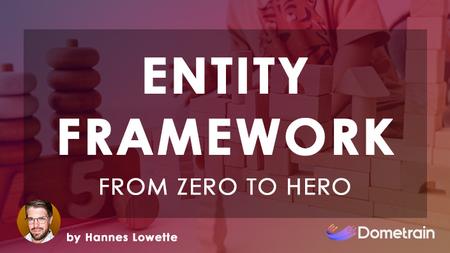English | MP4 | AVC 1920×1080 | AAC 44KHz 2ch | 82 Lessons (8h 32m) | 1.85 GB
Learn how to use Entity Framework Core in your .NET applications
Entity Framework (EF) Core is a lightweight, extensible, open source and cross-platform object-relational mapper or ORM which enables .NET developers to work with a database using .NET objects and eliminates the need for most of the data-access code that typically needs to be written. Alongside Dapper, it is one of the two most popular ORMs in .NET, and given how much its performance has been improved in the last few .NET versions, it is an excellent choice for any .NET application. In this 8-and-a-half-hour-long course, Hannes Lowette will cover everything you need to know about Entity Framework Core, from its most basic concepts to its most advanced ones, including testing and different database providers. This course is effectively two courses bundled as one, and it is the best resource you could have to learn Entity Framework code in .NET with C#.
Table of Contents
1 Welcome
2 What will you learn in this course
3 Who is the course for
4 What is an ORM
5 Where are ORMs useful
6 What is EF Core
7 Introducing the database context
8 How does a DbContext work
9 Section recap
10 The application we will build the data access for
11 Creating our first EFCore Model
12 Getting the Model to work in our application
13 Implementing data manipulation operations
14 Implementing query behavior
15 Seeing what goes on in the Database
16 Projecting data to optimize queries
17 Section recap (2)
18 Taking a look at the DB schema
19 Introducing DataAnnotations for our Model
20 Achieving similar results with FluentAPI
21 One-to-many relationships between entities
22 Converting between different data types
23 Using owned and complex types to group data
24 Generating values in the model
25 Hiding some database fields from our model
26 Applying global query filters
27 Section recap (3)
28 Why do we need migrations
29 The 2 migration philosophies
30 Adding our first migration
31 Adding migrations after changing the model
32 Executing Migrations from the CLI
33 Dealing with an out-of-sync model
34 The proper way to execute migrations
35 Section recap (4)
36 What are the challenges in tests with ORMs
37 Using Test databases
38 Using a database in memory
39 Faking DbSets in unit tests
40 The repository pattern
41 Integration testing with EF Core
42 Section recap (5)
43 Section recap (6)
44 Dependency Injection
45 Configuring Logging
46 DbContext Lifecycle
47 More on repositories
48 Different multi-tenant approaches
49 Multi-tenant with discriminators
50 Multi-tenant with separate databases
51 My take on architecture
52 Section recap (7)
53 More DbContext features
54 Using inheritance in your model
55 Using Alternate keys
56 One-to-one relationships
57 Many-to-many relationships
58 Using compound keys
59 Using raw SQL queries for your entities
60 Using keyless entities to query your database
61 Using the ChangeTracker for fun & profit
62 Section recap (8)
63 The typical types of performance issues
64 Slow Queries & DB indices
65 Using compiled queries to improve runtime performance
66 Using batching to execute bulk queries
67 Loading related data – strategies
68 Untracked query results
69 Solving Concurrency Issues
70 Section recap (9)
71 When the DB already exists
72 Using the DB to generate a model
73 How can we further evolve the model
74 Regenerating every time a demo
75 Keeping in sync manually a demo
76 Section recap (10)
77 EF Core isn’t just for SQL server
78 Using another RDBMS’s with EFCore
79 What is CosmosDB
80 Switching our system to CosmosDB
81 Section recap (11)
82 Conclusion
Resolve the captcha to access the links!
